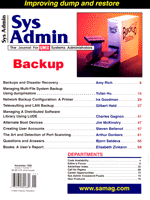
Editor's Forum
Gone are the days when you fit daily incremental backups onto a single 60MB cartridge tape. Gone, too, are the days of spending a couple of leisurely hours on a Saturday morning doing your weekly full backups, and cycling tape sets to your off-premise archive vault. Disk drive and storage vendors have listened to our chants of "more storage, more storage," and have given us 3.5-inch low-profile 9GB drives, 3.5-inch full-height 18GB disks, and storage systems built around such drives. We can now buy a seven-drive RAID array that uses the low-profile 9GB disks and fits into a space of about a foot cubed, such as the desktop FlashDisk RAID array from Winchester Systems. If we have the space (and the budget) for a tall rack, we can now get systems that pack close to 1TB or more in a single rack from vendors ranging from Artecon to Zzyzx. Of course, the other price we pay is devising a reliable backup plan for all that storage. The thematic articles in this issue address a variety of backup challenges. Central to all of these issues, however, is "The Plan." Planning how to best utilize your resources to perform the required backups within the available window of time is perhaps the most important task you can perform as a system administrator. Chances are that your organization's ability to recover from a data disaster will depend on that plan at some point. Unfortunately, horror stories abound regarding situations where The Plan failed, or didn't exist. The recent file fiasco at Stanford University where doctoral researchers lost years of work due to the lack of a good plan is just one example of many. As a result of preparing The Plan, you may conclude that you need more comprehensive backup software - a package that can improve the manageability of your backup plan. You may also decide that you need more, better, or larger tape libraries to squeeze all that backup into the small amount of time available to perform the task. When management balks at the expense, you will calmly ask them how many months of business can be suspended while the data is reconstructed. Some less-important project will get scrapped or delayed, you'll get your fancy, new tape library, and you will be happy again. Until, of course, you try to install the library. You may find that the snazzy software you bought does not directly support the new library. Perhaps, not even the tape density that your library's drives use. So, you will pow-wow with the vendors and find a workaround. Almost all of the libraries from major vendors will work with the most popular backup software in one way or another. You'll spend a few frustrating hours configuring the software to work with your library and be on your way to improved data security. I would suggest, however, that the pain you will suffer while installing and configuring the backup software and your new library is unnecessary. Backup vendors should work together to devise a better industry-wide architecture for backup hardware and software to work within. An architecture that would allow you to use the latest hardware with your software. And, one that would result in less-arcane user interfaces within the software. So, while the Beatles tune suggests that what the world needs now is love, I'd counter that we need a better foundation for The Plan. Come on, storage guys. We're paying big bucks for big backup, and we deserve better.
Sincerely yours, |